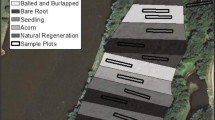Abstract
This experiment examined how elevation and control of early successional vegetation would affect the growth and survival of tree species used in restoration. Vegetation was controlled by either mowing or spraying with Accord [glyphosate,-(phosphononomethyl)glycine, in the form of its isopropylamine salt] herbicide. These control methods were applied to either the entire plot or a narrow 1-m strip where seedlings were to be planted. A fifth treatment (control) had seedlings planted into the existing vegetation. Species planted were baldcypress (Taxodium distichum), water tupelo (Nyssa aquatica), willow oak (Quercus phellos), Nuttall oak (Q. nuttallii), overcup oak (Q. lyrata), and cherrybark oak (Q. falcata var. pagodaefolia). Seedlings were randomly planted in late April 1993 with six rows in each plot and six trees per row on a 2×2 m spacing with five replicate plots per treatment. Survival was not enhanced by any competition control treatment, but survival among species differed. All six species had overall survival>90% in autumn 1993. Species survival was affected by several summer floods during 1994. Baldcypress and overcup oak survival was greater than 89%, while water tupelo, Nuttall oak, and willow oak were all approximately 70%, and cherrybark oak was only 29%. By the end of 1995, survival of all species decreased further, but the species groupings remained the same. Survival and height growth of baldcypress and water tupelo were greatest at lower planting elevations. At higher elevations, survival of cherrybark oak and willow oak were greatest, while overcup oak and Nuttall oak were unaffected by elevation. Thus, controlling the herbaceous vegetation did not affect survival or growth as much as relative planting elevation due to site flooding and the flood tolerance of the species. All of the species in this experiment except cherrybark oak were successfully established.
Similar content being viewed by others
Literature Cited
Allen, J. A. and H. E. Kennedy, Jr. 1989. Bottomland hardwood reforestation in the Lower Mississippi Valley. U.S. Fish and Wildlife Service, National Wetlands Research Center. Slidell, LA, USA, and USDA Forest Service, Southern Forest Experiment Station. Stoneville, MS, USA.
Clewell, A. F. and R. Lea. 1989. Creation and restoration of forested wetland vegetation in the southeastern United States. p. 199–237. In J. A. Kusler and M. E. Kentula (eds.) Wetland Creation and Restoration: The Status of the Science, Volume I: Regional Reviews. EPA/600/3-89/038.
Hook, D. D. 1984. Waterlogging tolerance of lowland tree species of the South. Southern Journal of Applied Forestry 8:136–149.
McKnight, J. S., D. D. Hook, O. G. Langdon, and R. L. Johnson. 1981. Flood tolerance and related characteristics of trees of the bottomland forest of the Southern United States. p. 29–69. In J. J. Clark and J. Benforado (eds.) Wetlands of Bottomland Hardwood Forests. Elsevier Scientific Press. Amsterdam. The Netherlands.
McLeod, K. W. and T. G. Ciravolo. 1999. Species selection and seedling establishment for restoration of bottomland forests. p. 222–236. In J. E. Cook and B. P. Oswald (compilers). Proceedings of the First Biennial North American Forest Ecology Workshop. Forest Ecology Working Group. Society of American Foresters. Bethesda, MD, USA.
McLeod, K. W., M. R. Reed, and T. G. Ciravolo. 1994. Selection of woody species for bottomland restoration. p. 106–118. In F. J. Webb, Jr. (ed.) Proceedings of the 21st Annual Conference on Wetlands Restoration and Creation. Hillsborough Community College, Tampa, FL, USA.
National Oceanic and Atmospheric Administration (NOAA). 1993–1996. Climatological data. Georgia, Annual Summary. National Climatic Data Center. Asheville, NC, USA.
Newling, C. J. 1990. Restoration of bottomland hardwood forests in the lower Mississippi Valley. Restoration and Management Notes 8:23–28.
Rogers, V. A. 1990. Soil Survey of the Savannah River Plants Area. Parts of Aiken, Barnwell and Allendale Counties, South Carolina. USDA Soil Conservation Service, Washington, DC, USA.
SAS Institute, Inc. 1996. SAS/STAT Software: Changes and Enhancements through Release 6.11. SAS Institute, Inc. Cary, NC, USA.
Schneider, R. L., N. E. Martin, and R. R. Sharitz. 1989. Impact of dam operations on hydrology and associated floodplain forests of southeastern rivers. p. 1113–1122. In R. R. Sharitz and J. W. Gibbons (eds.) Freshwater Wetlands and Wildlife. USDOE Office of Scientific and Technical Information, Oak Ridge, TN, USA. CONF-8603101, DOE Symposium Series No. 61.
Author information
Authors and Affiliations
Rights and permissions
About this article
Cite this article
McLeod, K.W., Reed, M.R. & Wike, L.D. Elevation, competition control, and species affect bottomland forest restoration. Wetlands 20, 162–168 (2000). https://doi.org/10.1672/0277-5212(2000)020[0162:ECCASA]2.0.CO;2
Received:
Revised:
Accepted:
Issue Date:
DOI: https://doi.org/10.1672/0277-5212(2000)020[0162:ECCASA]2.0.CO;2




